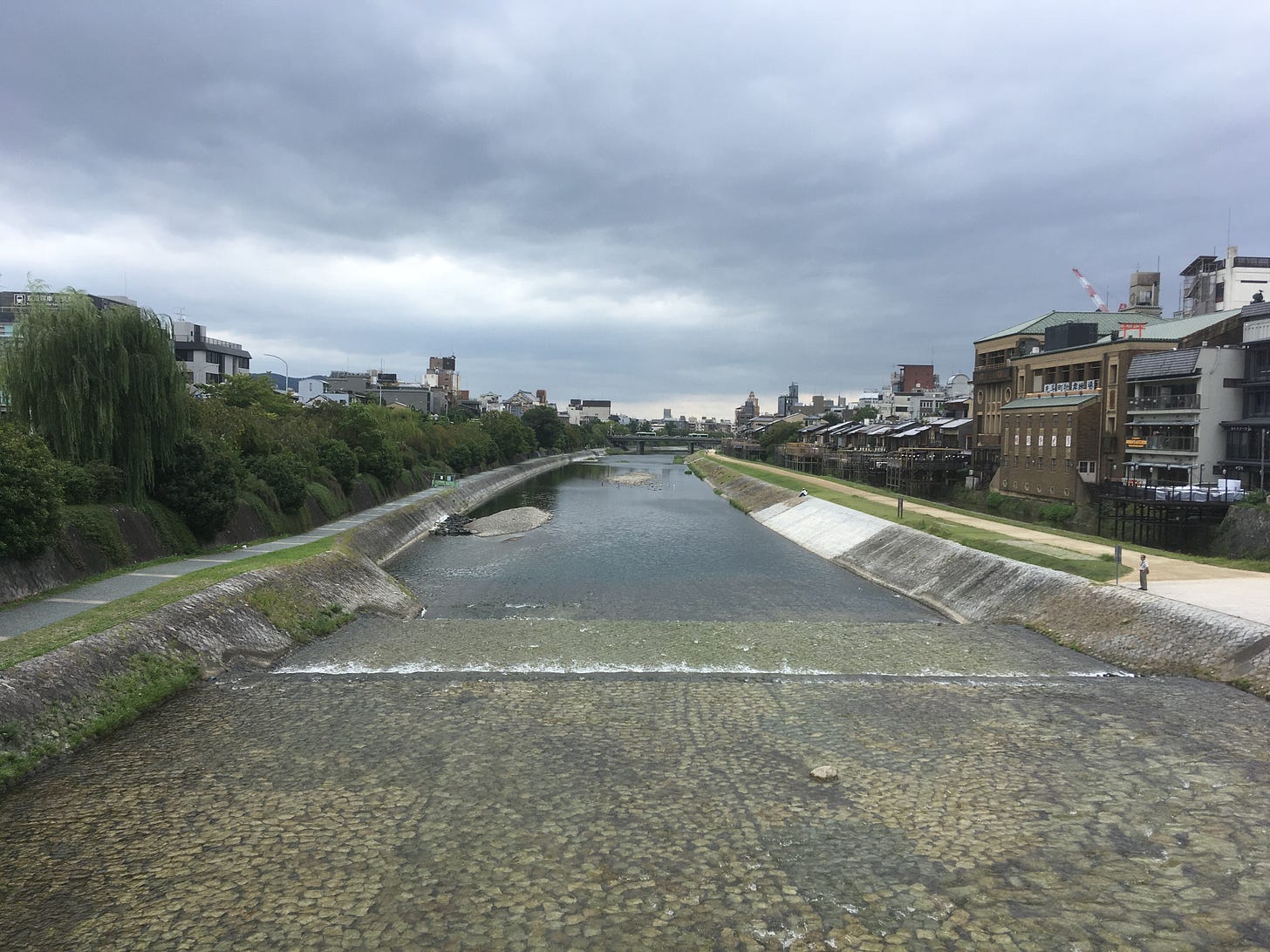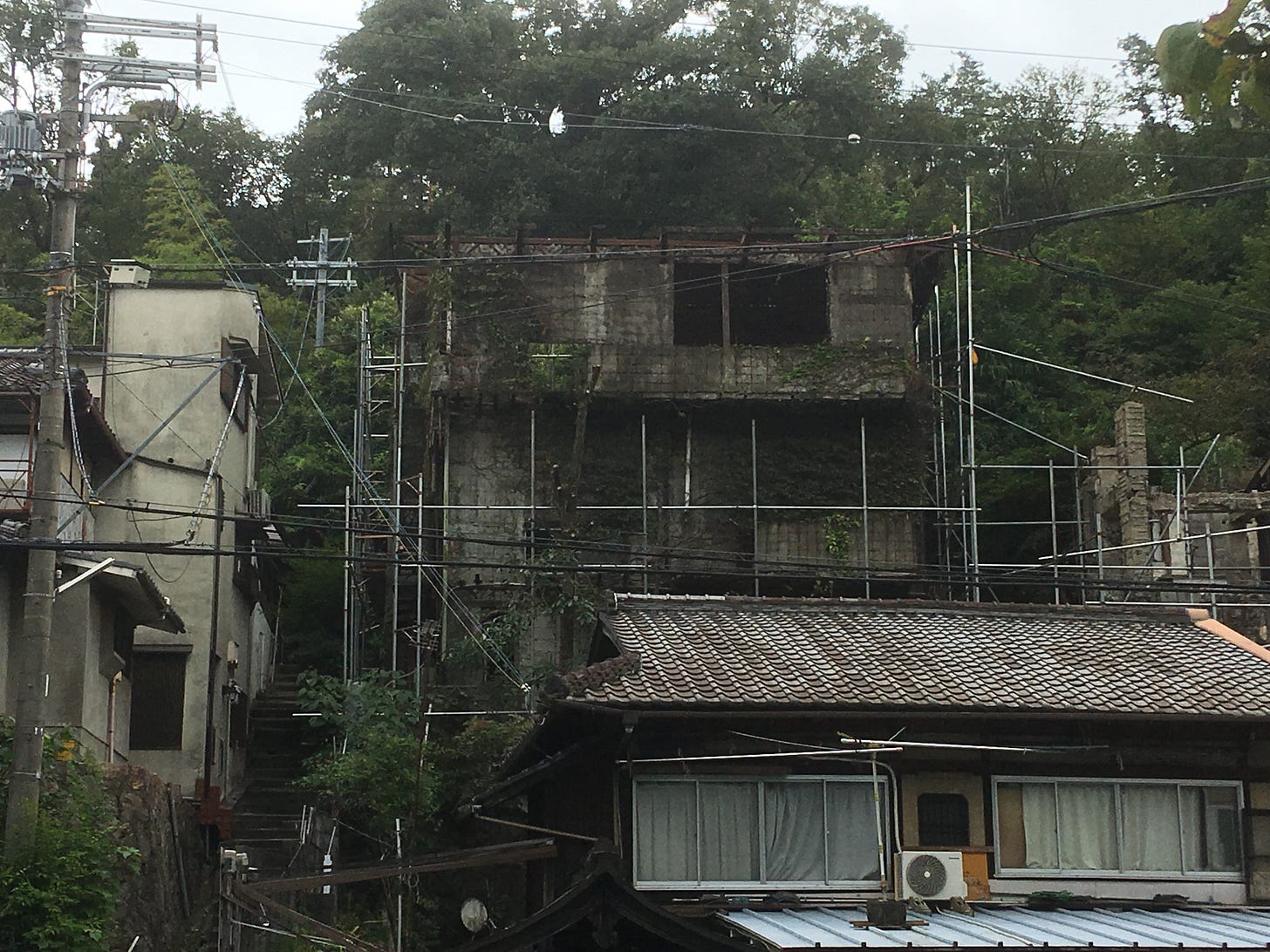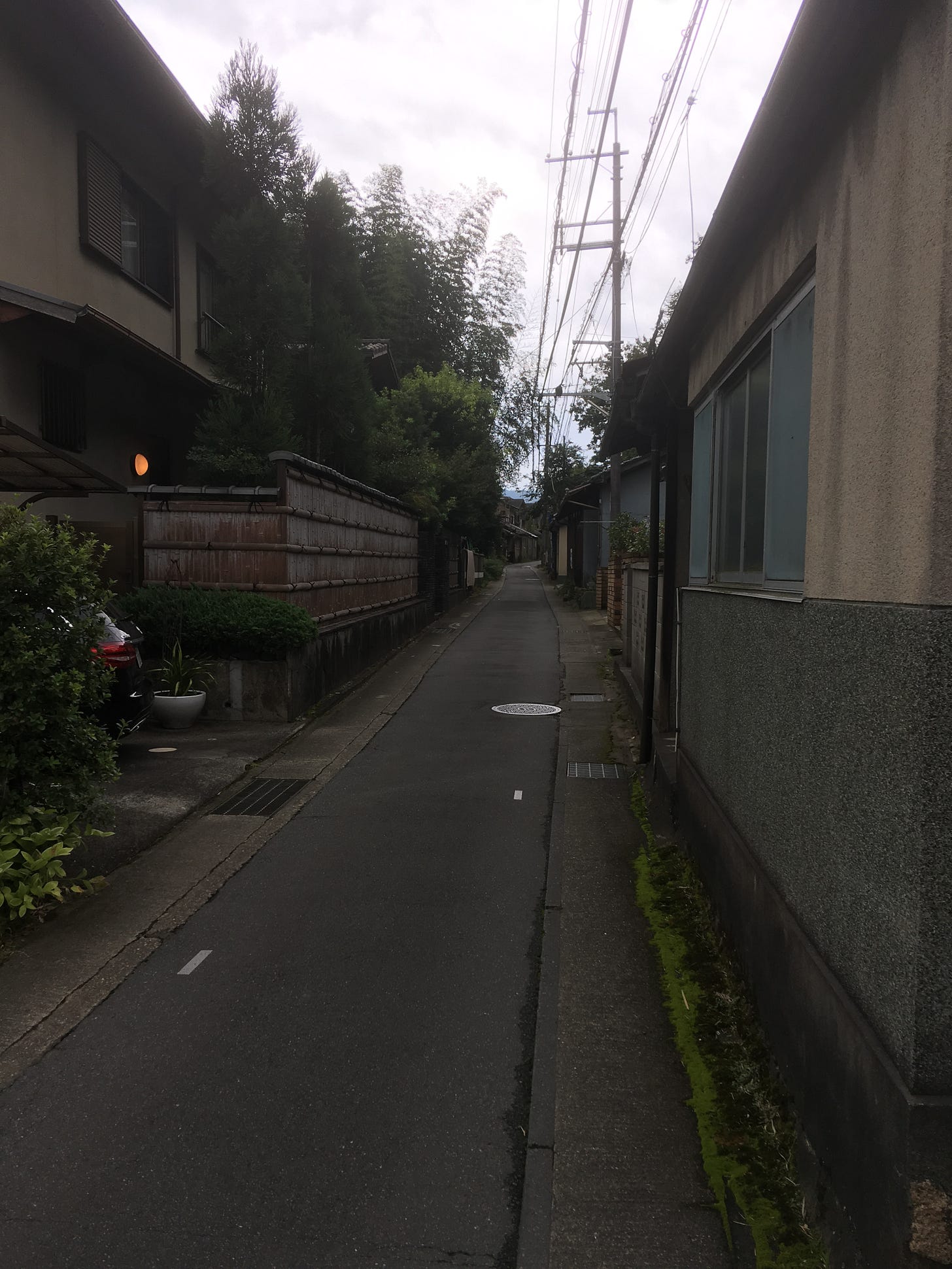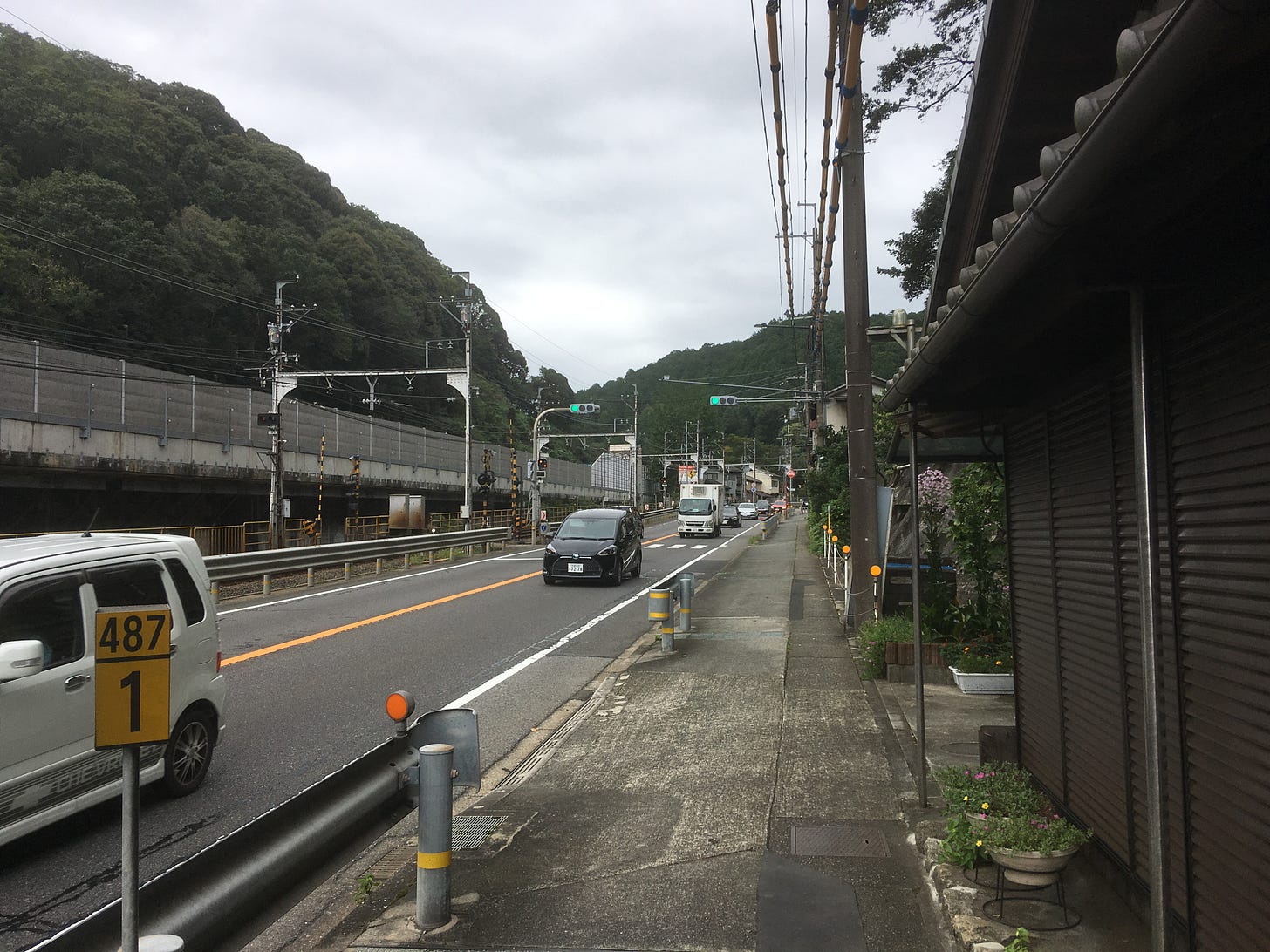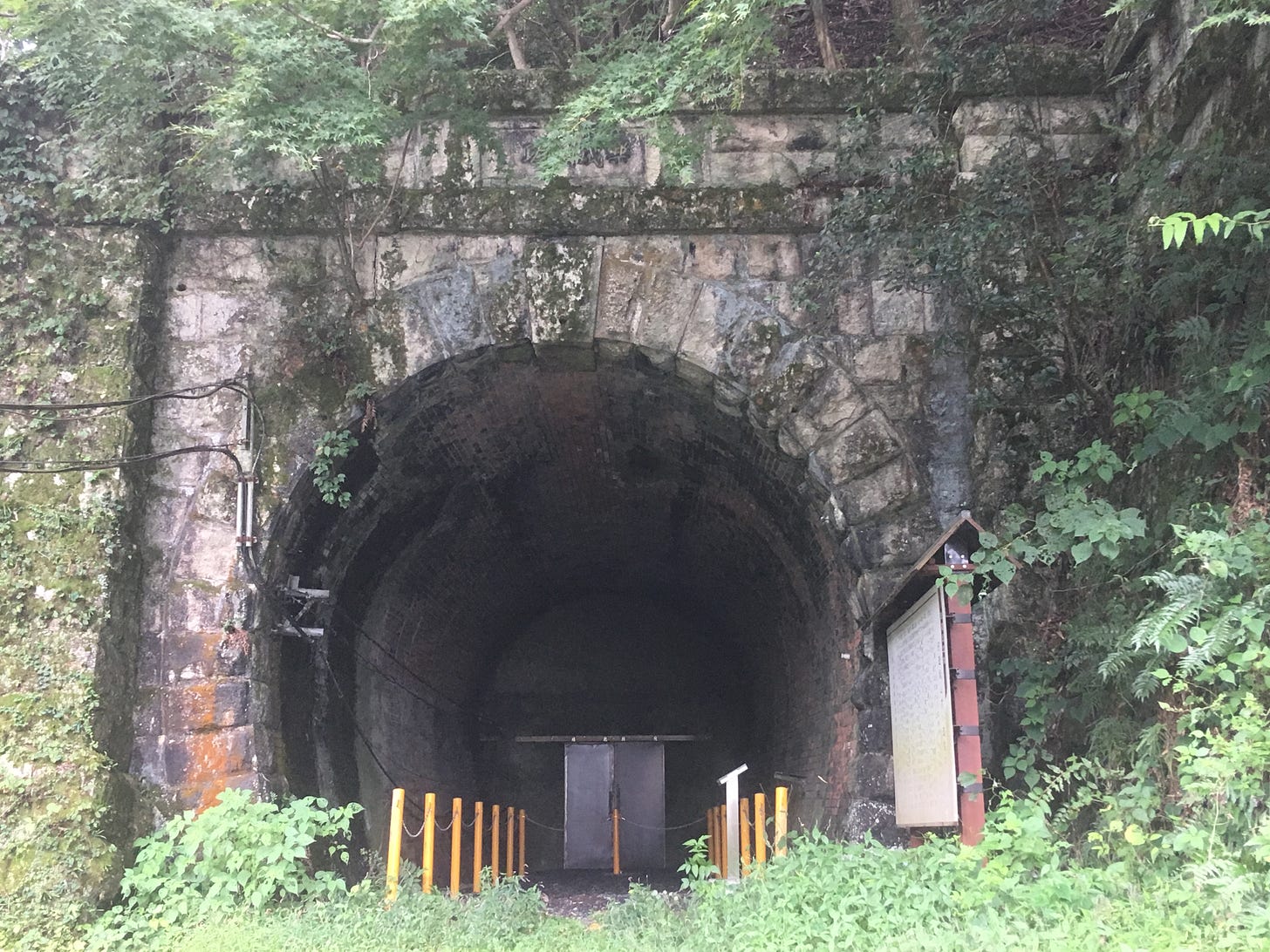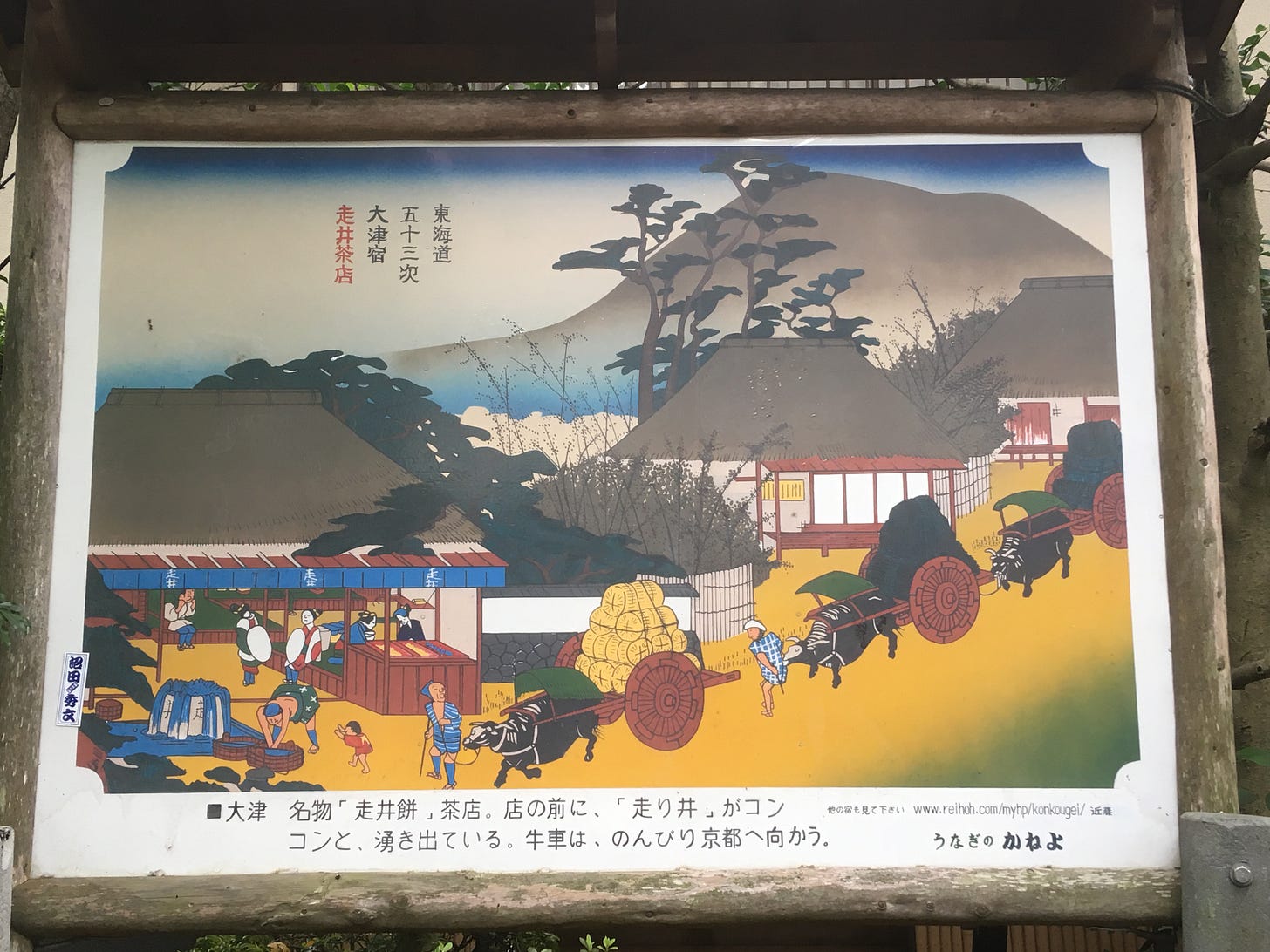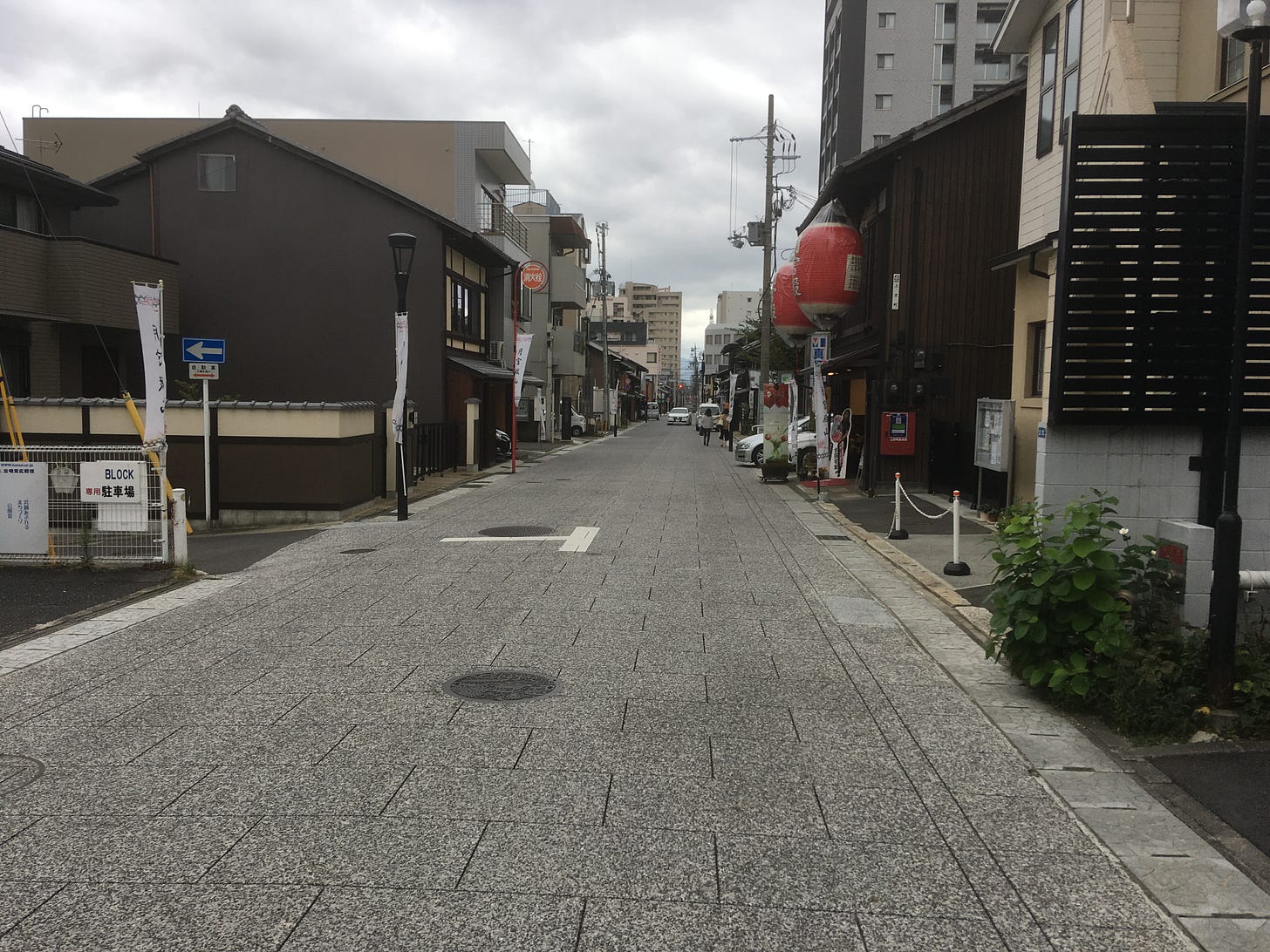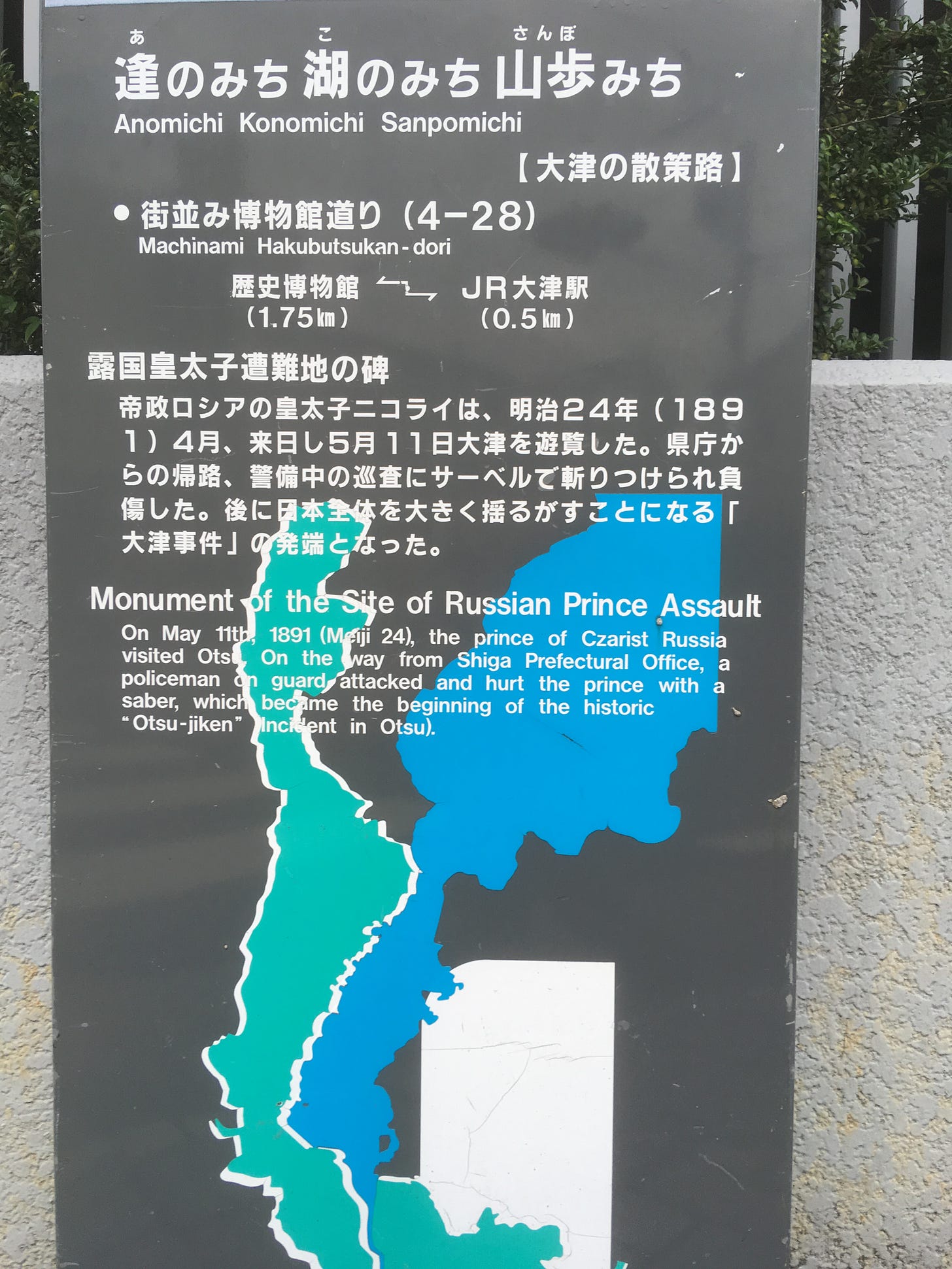The woodblock print shows a much wider river - the distant houses appear submerged, only the triangles of their roofs show above the waterline. Now the Kamogawa flows, carefully controlled, over weirs and between tree-lined banks. The long sweeping arch of the Sanjo bridge has been flattened for cars, only the decorative posts and railings of the original remain in modern form. Hiroshige’s woodblock print shows an eclectic mix of samurai, tradesmen, elegant ladies, footmen, travellers and tea-whisk sellers on the bridge. But today’s mix is simpler - salarymen, students and a lone traveller - me.
The sky is rippled grey and threatens drizzle. I set off the wrong way up the Tokaido, arrow straight across Kyoto’s grid system, towards the mountain ridge that marks the city’s eastern boundary. The Starbucks and crowds of Sanjo are soon left behind. I see a row of shuttered shops and delve a little into the back streets. I guessed from the closed shops what I would find. The shops belong to a post-war danchi apartment complex. All are permanently shuttered, except for one that provides wheelchairs and assistants for elderly people. I walk past, fallen laundry lies on cracked, moss-covered concrete, darkened by age and crept over by vines. It’s not quite a Napoli slum, but it’s as close as it gets in Japan, and for it to be so close to the glamorous riverside restaurants just a few hundred metres away is still surprising. Japan doesn’t really have the large sink housing estates that can be found in the UK, but it does have these little pockets of deprivation. Very few except the poor and old are eligible for government housing, so government housing ends up full of the poor and old.
Back on the Tokaido, the road rises to reach the mountains and bends sharply to the right, continuing its climb. This is where travellers left Kyoto, and the city’s water supply enters. Wood and grey tile has been replaced by red brick. The pump-houses remind me of my native Manchester, even more so when I find the old Lake Biwa to Kyoto canal, which soon disappears into a tunnel.
The pass that separates Kyoto from the neighbouring town of Yamashina closes in. Steep tree-covered slopes and vines cascade down on each side. A cinder-block house has been overtaken by the vines, they crawl over every surface and through the gaping holes where windows once were.
The old road breaks away to the right down a narrow lane. Old houses on the right, some so dilapidated that their leaky roofs are plugged with tarpaulin, and between them gaping holes of land that cannot be sold because of the landslide risk. The road drops steeply into Yamashina and I pause to eat a convenience store lunch in a slim riverside park.
As I leave Yamashina, I encounter Route 1 for the first time. Between the end of the old Tokaido and the beginning of the modern expressway network, this was the way from Kyoto to Tokyo. Along its route, I will find a decayed bubble era feel. There is no choice but to walk along it - the Osaka pass from Yamashina to Otsu narrows to a channel that only accommodates Route 1, Expressway 1 and the Keihan Keishin railway line.
Route 1 is still busy with everything that doesn’t want to use the tolled expressway. Trucks roar past close and higher up they howl on the expressway. In between, trains clatter up the incline. Is this what I expected from the Tokaido? It’s not a pretty walk. There is a hiking trail that connects Kyoto and Tokyo that is doubtless far more scenic. But I want to do more than just see forest trails. I want to see this key artery of Japan, an urban industrial historical belt connecting the key plains of Japan and containing over eighty percent of the country’s industry. What’s happening and changing along here will surely give some clues as to Japan’s past, present and future.
The Osaka pass (no connection to the city of the same name) is the first of the utamakura locations I will pass. These utamakura - poem pillows - are key sites along the old roads of Japan where travellers would stop and compose poetry from the Heian period onwards.
For the utamakura writers, the pass marked the leaving behind of the civilised world of Kyoto and friends, family and lovers there. Lady Sarashina, a lady-in-waiting for the Heian court wrote:
“Wooden fence set back by mountain, Half-made Buddha figure, So far from everyone in the middle of nowhere, Forbidding winds still blow, About the barrier gate of Osaka, Crying with that same voice I heard so long ago.”
Lady Nijo, travelling to Kamakura more than a hundred years later wrote:
“Barrier’s pure spring waters, Single cherry tree, These cherry blossoms, Halt the heart, Of the passerby, Barrier guard of sorts, On Osaka Mountain.”
(Poems from: Travels with a Writing Brush: Classical Japanese Travel Writing from the Manyoshu to Basho, Penguin Classics, 2019)
In these old poetry collections, the traveller usually starts in Kyoto (the then capital city) and makes their way northwards towards the then boundaries of civilised Japan at Kamakura and Edo. This made me feel a little less like I was going the wrong way, despite the numbering of stations along the Tokaido beginning at Tokyo and ending in Kyoto. Because of this numbering, the vast majority of walkers along the Tokaido start at the Tokyo end before heading south to Kyoto. In total, the Tokaido has 53 stations between the beginning and end points at Nipponbashi and Sanjo Bridge.
On the left, just before I head down into Otsu, I come across the end of an old railway tunnel, completed in 1880. This was the first railway tunnel to be designed and built in Japan purely by Japanese engineers. Japan’s first railway from Tokyo to Yokohama was built with British technical assistance. The Engineer Training College in Osaka was staffed by British engineers and trained the first group of Japanese engineers who would go on to build railways from Kobe to Kyoto and from Kyoto to Otsu. For this reason, Japanese trains run on the left track, and partly explains why the Japanese drive on the left too.
The purpose of these railways and canals connecting Kyoto to Otsu was to try and keep Kyoto relevant with the shift of the capital to Tokyo. There was a deep fear in Kyoto of a slide into irrelevance with the centralization of power around the emperor and the subsequent move of the imperial court from Kyoto to Tokyo.
The slope down into Otsu still has some of the original wheel ruts from the oxen-pulled carts that hauled goods up and down from Otsu port on Lake Biwa. To stop the road from deteriorating into a slippery, muddy slalom, stone wheel grooves were installed to guide the ox carts firmly up and down the slope. In this way, rice and other products could make their way from the plains of eastern Japan to Kyoto.
In Hiroshige’s print of Otsu, he portrays three ox carts heading down the slope into the town. One of the ox carts is piled with rice bundles, two are carrying firewood. At the bottom of the slope, outside a teahouse, a well bubbles up. For the tired ox cart handlers and travellers this must have been a welcome respite. There is no such respite for me, the bubbling waters and teahouses are long gone, convenience stores with toilets are their modern replacement.
The expressway has disappeared by the time I head into Otsu. Only the railway and Route 1 are left. After a while even the railway no longer stays separate, and to my surprise starts running along the road like a tramway. The sky is darkening, but still, it doesn’t rain, and the Tokaido is now a street of neat granite flagstones running between old and faux-old wooden houses.
I had made it to Otsu incident free. However, on the 11th of May 1891, a visiting Russian prince was not so lucky and was attacked by a policeman with a sabre, the beginning of the “Otsu Incident”. A sign on the street corner marks the spot where Czarevitch Nicholas, the Czar’s son, was attacked by a sabre-wielding police officer. The visit of Czarevitch Nicholas was the most important royal visit to Japan for nearly a decade. It was a mark of Japan’s improved status in the world following the Meiji restoration and subsequent modernization of Japan’s economic and political systems.
Tsuda Sanzo, the assailant from Samurai stock, had been a hero in the Imperial Army during its fight against the Satsuma (modern day Kagoshima) rebellion in 1877. But now, he was a mere policeman, holding back cheering crowds, guarding a procession of rickshaws containing local dignitaries and members of the Russian royal family. On their journey up to Kyoto, the Russians had stopped off at Satsuma. Not only that, but Japan had also given up its claim to the southern part of the island of Sakhalin in 1875 and ceded it to Russia, just two years before the Satsuma rebellion.
The anger at these slights burst forth in a lunge at the Czarevitch’s head from the policeman’s sabre, dealing Nicholas a gash to the forehead. An attempted second lunge was parried by a bamboo whip held by Nicholas’s cousin George. Nicholas tried to run into the crowd. The crowd scattered. Nicholas’s rickshaw driver tackled the policeman, and the sabre was knocked away. Nicholas was injured but safe.
The immediate reaction following the incident was fear. Would the Russians attack? Their fleet in Kobe harbour outnumbered the Japanese ships there. The Japanese military was modernising, but few felt it was ready to defend against an adversary like Russia. The emperor rushed down from Tokyo to check on the Czarevitch’s condition. Nicholas reassured the emperor that he was fine. It was just a flesh wound.
After the fear, came the shame. The incident dealt a blow to Japan’s attempts to present itself to the western powers as a modern nation. Japan was in the process of trying to renegotiate treaties with the western powers that allowed them extraterritoriality (crimes committed by their citizens wouldn’t be tried in local courts, but by the courts of the foreign powers). The fear that Japan was too lawless, too full of assassins, to provide legal protection to foreign citizens was a big part of their unwillingness to give up extraterritoriality. A few years earlier, the Japanese emperor had commented on the small size of the protective entourage for the American president compared to his own large protection force.
There was an outpouring of sympathy for the injured Czarevitch. Huge numbers of presents and telegrams were sent to his ship. Such was the shame in Tsuda’s home village, that they banned the family name Tsuda and the given name Sanzo. On May 20th, Yuko Hatakeyama, stabbed herself to death in front of the Kyoto prefectural office in an attempt to expiate the crime.
The fear of Russian power at this time contrasts with the increased confidence felt on the eve of the Russo-Japanese war of 1904 to 1905. The intervening years had seen Japanese confidence build with a victory in the Sino-Japanese war of 1894 to 1895. The hated treaties with their extraterritoriality clauses were replaced by ones that put Japan on more of an equal footing with the western powers. In the Russo-Japanese war, Japan would reclaim the southern part of Sakhalin Island. And the Czarevitch Nicholas? Well, he was now the Czar Nicholas the Second.
Today’s walk was over. And finally, it rained. A whole day of threatening clouds gave way, and it poured so that by the time I found the station I was soaked despite trying to stop under every shop awning and bit of shelter I could find.





